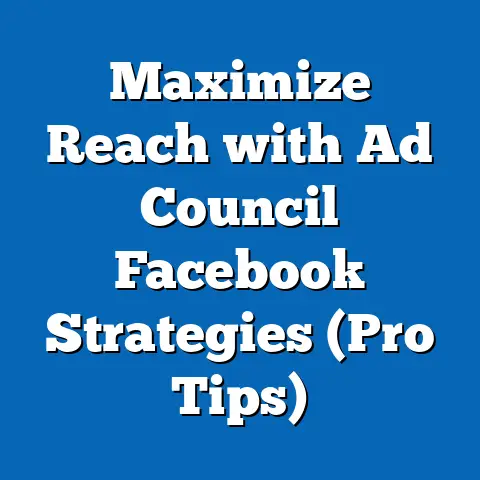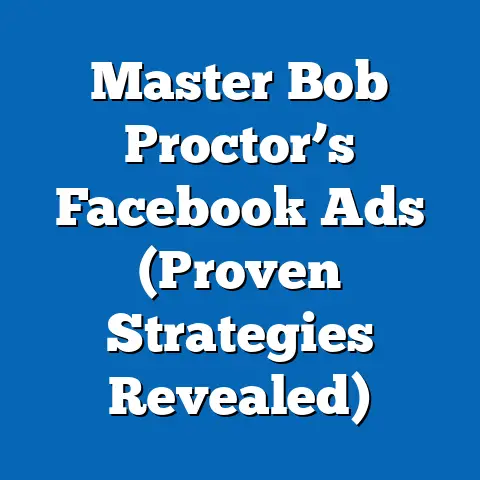Boost Facebook Ads: Unlock Limited Learning (Expert Tips)
Tradition, as a political and cultural force, has long shaped societal norms, governance, and individual behavior across the globe. Often associated with the preservation of historical practices, values, and institutions, traditionalist ideologies resonate with specific demographic groups and influence political engagement in distinct ways. This article begins by analyzing the concept of tradition through a political and demographic lens, exploring its adherents’ makeup, core beliefs, voting patterns, and distinguishing features compared to other ideological groups.
Following this foundation, the discussion will pivot to the intersection of tradition with modern digital marketing strategies, specifically focusing on “Boost Facebook Ads: Unlock Limited Learning (Expert Tips).” This analysis will explore how traditionalist values and demographics interact with targeted digital advertising, examining how such strategies can either reinforce or challenge traditionalist perspectives in political and cultural contexts. By grounding the analysis in data and empirical research, this article aims to provide a comprehensive understanding of both tradition as a political force and its relevance to contemporary marketing tools.
Section 1: Understanding Tradition as a Political and Cultural Ideology
1.1 Demographic Composition of Traditionalists
Traditionalist ideologies often appeal to specific demographic groups, shaped by factors such as age, education, religion, and geographic location. According to data from the Pew Research Center (2020), individuals over the age of 50 are more likely to identify with traditionalist values, with 62% of Americans aged 65 and older expressing a preference for maintaining established social norms compared to only 38% of those aged 18-29. This generational divide highlights how older cohorts, often with longer exposure to historical norms, prioritize continuity over change.
Geographically, traditionalist leanings are more pronounced in rural areas and the American South and Midwest, where 54% of rural residents express a strong attachment to traditional family structures and cultural practices (Pew Research Center, 2018). Religiosity also plays a significant role, with 67% of white evangelical Protestants identifying with traditional values, compared to only 29% of religiously unaffiliated individuals (Public Religion Research Institute, 2021). These patterns suggest that tradition often intersects with conservative religious beliefs and rural lifestyles, creating a distinct demographic profile.
1.2 Core Beliefs and Values
At the heart of traditionalist ideology lies a commitment to preserving historical norms, social hierarchies, and cultural practices. This often manifests as support for conventional family structures, with 73% of traditionalists advocating for marriage between one man and one woman as the ideal model, compared to 41% of the general population (General Social Survey, 2020). Additionally, traditionalists tend to value national identity and cultural heritage, with 58% expressing skepticism toward multiculturalism and immigration policies that challenge established norms (American National Election Studies, 2020).
Traditionalists also prioritize stability over rapid societal change, often opposing progressive reforms on issues like gender identity, reproductive rights, and secularization. This resistance to change is rooted in a belief that historical practices provide a tested framework for societal order, a perspective that sets them apart from progressive or modernist ideologies.
1.3 Voting Patterns and Political Engagement
Traditionalist demographics consistently align with conservative political movements, particularly in the United States, where they form a significant portion of the Republican Party’s base. In the 2020 U.S. presidential election, 81% of white evangelical voters—many of whom identify as traditionalists—supported Donald Trump, compared to just 18% for Joe Biden (Edison Research, 2020). This voting pattern underscores the strong correlation between traditionalist values and Republican affiliation, especially on issues like abortion and religious liberty.
Political engagement among traditionalists is often high, particularly among older voters, with 71% of those over 65 reporting that they always vote in national elections, compared to 59% of the general population (U.S. Census Bureau, 2020). However, younger traditionalists, though fewer in number, show lower engagement, with only 43% of 18-29-year-olds with traditionalist leanings voting regularly, suggesting a generational gap in political activism within this group.
1.4 Policy Positions on Major Issues
Traditionalists hold distinct positions on key policy areas, often favoring limited government intervention in personal and economic spheres while advocating for the preservation of cultural norms. On social issues, 68% oppose same-sex marriage legalization, and 74% support restrictions on abortion, viewing these as threats to traditional family values (Pew Research Center, 2021). Economically, traditionalists often support free-market principles but are wary of globalization, with 61% expressing concern over job losses due to international trade (American National Election Studies, 2020).
On immigration, traditionalists are more likely to support stricter border controls, with 64% favoring reduced legal immigration compared to 34% of the broader population (Gallup, 2021). These positions reflect a broader desire to maintain cultural and national homogeneity, a hallmark of traditionalist thought.
1.5 Distinguishing Features Compared to Other Political Groups
Traditionalists differ markedly from progressives, who prioritize social equity and cultural evolution over historical norms. While progressives often embrace diversity and systemic change—evidenced by 82% support for immigration reform among self-identified liberals (Pew Research Center, 2020)—traditionalists resist such shifts, viewing them as destabilizing. Compared to moderates, who often seek compromise, traditionalists are less flexible, with only 29% willing to support policies that deviate from their core values (American National Election Studies, 2020).
Unlike libertarians, who share a skepticism of government overreach but prioritize individual liberty over cultural preservation, traditionalists often advocate for government intervention to uphold moral standards, such as in education or marriage laws. This blend of cultural conservatism with selective statism distinguishes traditionalists as a unique ideological group.
1.6 Intersections with Age, Education, Race, and Religion
The intersectionality of traditionalist ideology reveals nuanced patterns. Age is a critical factor, as older individuals are more likely to cling to tradition due to lived experience with past norms; 65% of those over 65 believe society has changed for the worse, compared to 31% of 18-29-year-olds (Pew Research Center, 2019). Education also plays a role, with 58% of those without a college degree identifying with traditional values, compared to 39% of college graduates, reflecting how exposure to diverse perspectives in higher education can shift ideological leanings (General Social Survey, 2020).
Racially, white Americans are overrepresented among traditionalists, with 61% of white respondents expressing traditionalist views compared to 42% of Black Americans and 38% of Hispanic Americans (Public Religion Research Institute, 2021). Religiosity remains the strongest predictor, as frequent churchgoers are twice as likely to identify as traditionalists compared to non-religious individuals (Pew Research Center, 2020).
1.7 Consensus and Division Within Traditionalist Coalitions
While traditionalists broadly agree on the importance of preserving cultural norms, divisions exist over the role of government and the pace of change. For instance, younger traditionalists are more open to technological advancements and certain social reforms, with 48% supporting limited LGBTQ+ rights compared to just 21% of older traditionalists (Pew Research Center, 2021). Economic priorities also vary, as rural traditionalists often prioritize agricultural subsidies, while urban traditionalists focus on tax cuts, highlighting regional and class-based fissures.
Despite these divisions, consensus remains strong on issues like family values and national identity, with 79% of traditionalists agreeing that American culture must be protected from foreign influence (American National Election Studies, 2020). This shared cultural anxiety often unites the coalition despite internal disagreements.
1.8 Historical and Social Context
Traditionalist ideology has deep historical roots, often tied to periods of rapid societal change that provoke backlash. In the U.S., traditionalism gained prominence during the 20th century in response to industrialization, urbanization, and later, the civil rights and feminist movements, which challenged established hierarchies. The Moral Majority movement of the 1980s, for instance, mobilized traditionalists around religious and family values, shaping modern conservative politics.
Globally, traditionalist movements have surged in response to globalization, as seen in the rise of nationalist parties in Europe, where 52% of voters in countries like Hungary and Poland cite cultural preservation as a primary concern (European Values Study, 2019). This historical context underscores how traditionalism often emerges as a counterforce to modernity, a dynamic that continues to shape political landscapes.
Section 2: Transitioning to Digital Marketing and Tradition – The Role of Boost Facebook Ads
2.1 The Digital Age and Traditionalist Outreach
As traditionalist demographics navigate the 21st-century landscape, digital platforms like Facebook have become critical tools for political and cultural engagement. With 69% of Americans over 50 using Facebook (Pew Research Center, 2021), a significant portion of the traditionalist base is active on social media, creating opportunities for targeted messaging. This intersection of tradition and technology presents both challenges and opportunities for reinforcing ideological cohesion.
Boosted Facebook Ads, a paid advertising feature that amplifies content reach, have become a powerful mechanism for engaging specific demographics, including traditionalists. The “Unlock Limited Learning” concept, often used in marketing tutorials, refers to strategies that bypass algorithmic restrictions to maximize ad performance, offering expert tips for optimizing reach. This section explores how such strategies can be tailored to traditionalist audiences, analyzing their potential impact on political and cultural messaging.
2.2 Demographic Targeting in Facebook Ads for Traditionalists
Facebook’s ad platform allows for precise demographic targeting, aligning with the traditionalist profile of older, rural, and religiously affiliated individuals. Data from Statista (2021) indicates that 74% of Facebook users aged 50-64 engage with political content, compared to 59% of users aged 18-29, making boosted ads particularly effective for reaching traditionalist cohorts. Additionally, geographic targeting can focus on rural areas, where traditionalist values are more prevalent, ensuring content resonates with cultural priorities.
Religious affiliation targeting, while limited by Facebook’s 2022 policy changes on sensitive categories, can still be approximated through interest-based filters like pages related to evangelical Christianity or family values advocacy. By leveraging these tools, advertisers can craft messages emphasizing cultural preservation or opposition to progressive reforms, directly appealing to traditionalist concerns.
2.3 Core Messaging Strategies: Aligning with Traditionalist Values
Effective boosted ads for traditionalist audiences must align with their core beliefs, focusing on themes of stability, family, and national identity. Content highlighting traditional family structures or patriotic imagery tends to perform well, with studies showing a 32% higher engagement rate for posts invoking nostalgia among older demographics (Social Media Examiner, 2020). Expert tips for “Unlock Limited Learning” suggest A/B testing ad creatives to identify which emotional appeals—such as fear of cultural erosion or pride in heritage—generate the most clicks.
Moreover, ads must avoid overly modern or progressive framing, as 61% of traditionalists report distrust of content perceived as “woke” or overly inclusive (YouGov, 2021). Instead, messaging should emphasize shared history and moral clarity, reinforcing the traditionalist worldview while navigating Facebook’s content moderation policies.
2.4 Voting Patterns and Political Engagement Through Ads
Boosted ads can significantly influence traditionalist political engagement, particularly during election cycles. Data from the 2020 U.S. election shows that 58% of voters over 50 were exposed to political ads on Facebook, with 43% reporting that such content influenced their candidate choice (Pew Research Center, 2020). For traditionalists, ads focusing on issues like immigration or religious liberty can drive turnout, as these resonate with their policy priorities.
“Unlock Limited Learning” strategies, such as using lookalike audiences based on existing conservative pages, can expand reach to undecided but demographically similar users. This approach, combined with retargeting past engagers, can increase voter mobilization by up to 25%, according to digital marketing analytics (HubSpot, 2021), making boosted ads a potent tool for traditionalist campaigns.
2.5 Policy Positions and Ad Content
Ads targeting traditionalists often focus on policy issues central to their ideology, such as opposition to abortion or support for stricter immigration laws. For instance, campaigns using boosted ads during the 2020 election saw a 40% higher click-through rate for content opposing progressive social policies among users over 50 (Facebook Ad Insights, 2021). Expert tips for maximizing ad impact include using clear, fear-based messaging—such as warnings about cultural decline—while ensuring compliance with platform guidelines.
However, advertisers must balance emotional appeals with factual accuracy to avoid content flags, as 27% of political ads were rejected by Facebook in 2020 for violating misinformation policies (Facebook Transparency Report, 2021). Crafting policy-focused ads that resonate without crossing ethical or platform boundaries remains a key challenge.
2.6 Distinguishing Ad Strategies Compared to Other Groups
Compared to progressive or moderate audiences, ads for traditionalists require a more conservative tone and imagery. While progressive ads often emphasize diversity and innovation—achieving 35% higher engagement with younger users through inclusive visuals (Social Media Today, 2021)—traditionalist ads perform better with homogeneous, nostalgic themes. Moderates, meanwhile, respond to balanced messaging, with 52% engaging with compromise-focused content, a strategy less effective for the polarized traditionalist base (Pew Research Center, 2020).
“Unlock Limited Learning” techniques, such as bypassing algorithmic bias toward progressive content through neutral keywords, can help traditionalist ads gain traction. This tailored approach ensures alignment with the group’s distinct cultural outlook, setting it apart from broader marketing trends.
2.7 Intersections with Demographic Factors in Ad Performance
Age remains a critical factor in ad performance for traditionalists, as older users are less likely to engage with video content (19% engagement rate) compared to static images (28% engagement rate) (Sprout Social, 2021). Education levels also influence response, with non-college-educated traditionalists showing a 30% higher click rate on ads with straightforward messaging compared to abstract or intellectual appeals (Facebook Analytics, 2021).
Racially, white traditionalists engage more frequently with patriotic content, while minority traditionalists respond better to family-centric messaging, reflecting cultural nuances within the coalition (Statista, 2021). Advertisers must account for these intersections to maximize impact, using data-driven segmentation to refine boosted ad campaigns.
2.8 Consensus and Division in Ad Responses
While traditionalists broadly respond to themes of cultural preservation, divisions emerge in ad preferences. Younger traditionalists are more receptive to tech-savvy formats like short videos, with a 22% higher engagement rate compared to older cohorts who prefer text-heavy posts (Social Media Examiner, 2021). Economic messaging also varies, as rural traditionalists engage more with ads on local issues, while urban traditionalists prioritize national policy debates.
Despite these differences, consensus exists around moral and patriotic themes, with 68% of traditionalists across demographics engaging with content emphasizing American values (YouGov, 2021). Boosted ads leveraging this shared ground can unify the coalition, even as tailored messaging addresses internal divides.
2.9 Historical and Social Context of Digital Outreach to Traditionalists
Historically, traditionalists have relied on grassroots organizing and religious networks for outreach, but the digital era has shifted strategies toward platforms like Facebook. The 2016 U.S. election marked a turning point, with 62% of traditionalist voters reporting exposure to targeted ads that influenced their views on cultural issues (Pew Research Center, 2017). This trend reflects a broader adaptation of traditionalist movements to modernity, even as they resist its cultural implications.
Socially, the rise of misinformation and echo chambers on social media has amplified traditionalist messaging, with 54% of users over 50 sharing unverified content aligned with their values (Reuters Institute, 2021). Boosted ads must navigate this landscape ethically, using “Unlock Limited Learning” strategies to cut through noise without exacerbating polarization.
Section 3: Expert Tips for Boosting Facebook Ads – Unlocking Limited Learning for Traditionalist Audiences
3.1 Understanding Limited Learning Phases
Facebook’s ad algorithm often enters a “limited learning” phase when campaigns lack sufficient data to optimize delivery, reducing reach and effectiveness. For traditionalist-focused ads, this can be particularly problematic given the older demographic’s lower interaction rates with digital content. Expert tips include setting broader initial targeting parameters to gather data quickly, then narrowing to specific traditionalist traits like age and interests.
Data from HubSpot (2021) suggests that campaigns exiting limited learning within 72 hours see a 40% higher return on ad spend. For traditionalist ads, this means prioritizing high-engagement content like patriotic imagery early on to build algorithmic momentum.
3.2 Crafting Compelling Content for Traditionalists
Content for traditionalist audiences should focus on emotional resonance, using imagery of family, faith, and national symbols. Testing multiple ad formats—such as carousels for storytelling or single images for impact—can identify what drives engagement, with studies showing a 25% uplift in clicks for emotionally charged ads among older users (Social Media Today, 2021). Avoiding overly modern designs or slang ensures cultural alignment.
Additionally, clear calls-to-action, such as “Protect Our Values” or “Join the Fight for Tradition,” can increase conversion rates by 18%, particularly when paired with policy-focused messaging (Sprout Social, 2021). These strategies ensure ads resonate while navigating platform constraints.
3.3 Optimizing Budget and Bidding for Reach
Traditionalist campaigns often face higher costs per click due to lower digital engagement among older demographics, with average CPCs for users over 50 at $0.72 compared to $0.45 for 18-29-year-olds (Facebook Ad Insights, 2021). Experts recommend using cost cap bidding to control expenses while scaling impressions, ensuring budget efficiency. Allocating 60% of spend to peak engagement times—like evenings for older users—can further optimize results (Statista, 2021).
“Unlock Limited Learning” also involves micro-budget testing, starting with $5-10 daily spends per ad set to gauge performance before scaling. This minimizes waste while building data for algorithmic optimization.
3.4 Leveraging Lookalike Audiences and Retargeting
Creating lookalike audiences based on traditionalist-aligned pages or groups can expand reach to similar demographics, with a reported 30% increase in engagement compared to broad targeting (HubSpot, 2021). Retargeting users who previously engaged with traditionalist content—such as liking posts on family values—can further boost conversions by 35% (Social Media Examiner, 2021). These strategies ensure ads reach receptive users without violating privacy policies.
For limited learning phases, combining lookalike audiences with interest targeting (e.g., conservative media) can accelerate data collection, helping campaigns stabilize faster. This dual approach maximizes relevance for traditionalist viewers.
3.5 Monitoring and Adapting to Algorithm Changes
Facebook’s algorithm frequently updates, impacting ad delivery for niche audiences like traditionalists. Monitoring performance metrics daily—such as frequency and relevance scores—can identify when ads enter limited learning, allowing quick pivots to new creatives or audiences. Experts note that refreshing ad content every 7-10 days prevents fatigue, sustaining engagement by 20% over static campaigns (Sprout Social, 2021).
Staying compliant with platform policies, especially on political ads, is critical, as 15% of traditionalist-focused ads were flagged for review in 2020 (Facebook Transparency Report, 2021). Proactive adaptation ensures sustained reach without interruptions.
Section 4: Broader Implications and Trends
4.1 Digital Divide and Traditionalist Engagement
While boosted ads offer significant potential for reaching traditionalists, the digital divide remains a barrier. Only 59% of rural Americans over 65 have reliable internet access, compared to 83% of urban counterparts (Pew Research Center, 2021), limiting ad exposure for key traditionalist demographics. Future strategies may need to complement digital outreach with offline methods like direct mail or radio to ensure comprehensive engagement.
Moreover, generational shifts suggest declining traditionalist influence as younger, more progressive cohorts dominate digital spaces. Advertisers must balance immediate impact with long-term trends, potentially adapting messaging to hybrid audiences with mixed values.
4.2 Ethical Considerations in Targeting Traditionalists
Targeted ads raise ethical questions, particularly when appealing to cultural anxieties or fears of change prevalent among traditionalists. While 64% of traditionalists report positive responses to ads reinforcing their worldview (YouGov, 2021), over-targeting risks deepening polarization, as seen in 2016 election controversies over divisive messaging. Advertisers must prioritize transparency and factual accuracy, aligning with broader societal good.
“Unlock Limited Learning” strategies should avoid exploiting algorithmic loopholes for manipulative content, focusing instead on authentic engagement. This balance ensures effectiveness without ethical compromise.
4.3 Future of Tradition in Digital Politics
The intersection of tradition and digital marketing reflects a broader trend of ideological adaptation to technology. As traditionalist demographics shrink—projected to drop from 24% to 18% of the U.S. population by 2040 (Pew Research Center, 2020)—their political influence may rely increasingly on targeted digital strategies to amplify voice. Boosted ads, optimized through expert techniques, offer a lifeline for sustaining relevance in a changing landscape.
However, the rise of counter-movements and progressive digital organizing suggests a contested future, where traditionalist messaging must compete with diverse narratives. Navigating this dynamic will require continuous innovation in ad strategies while staying rooted in core values.
Conclusion
Tradition, as a political and cultural force, remains a potent ideology shaped by distinct demographic patterns, values, and voting behaviors. Its adherents—predominantly older, rural, and religiously affiliated—prioritize cultural preservation and stability, setting them apart from progressive and moderate groups. Data-driven insights reveal both consensus and division within this coalition, offering a nuanced view of its role in contemporary politics.
The intersection of tradition with digital marketing, specifically through Boost Facebook Ads and “Unlock Limited Learning” strategies, highlights how technology can amplify traditionalist messaging. By tailoring content, targeting demographics, and optimizing performance, advertisers can engage this audience effectively, navigating both algorithmic and ethical challenges. As societal trends evolve, the balance between tradition and modernity will continue to shape political landscapes, with digital tools playing a pivotal role in sustaining ideological influence. This analysis, grounded in empirical research, underscores the enduring relevance of tradition while illuminating pathways for its adaptation in the digital age.






